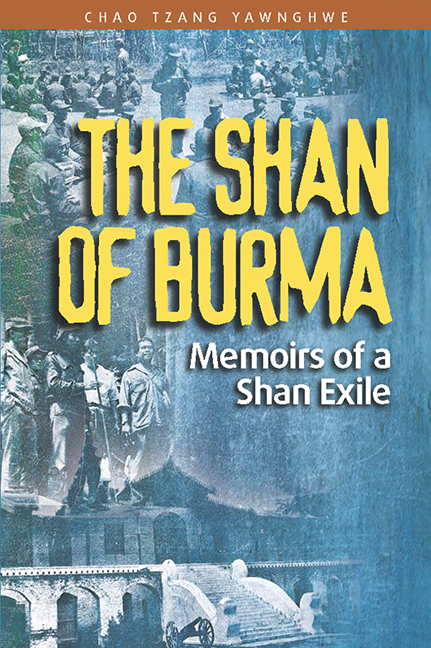Book contents
- Frontmatter
- Contents
- Foreword
- In Memorium
- Preface
- Acknowledgements
- PART ONE AN AUTOBIOGRAPHICAL INTRODUCTION
- PART TWO SHAN-BURMESE RELATIONS
- 2 An Overview of Shan-Burmese Relations
- 3 The Development of Shan-Burmese Relations
- 4 Shan-Burmese Relations from 1948
- PART THREE WHO'S WHO IN SHAN STATE POLITICS
- APPENDICES
- Abbreviations
- Glossary
- Bibliography
- Index
- The Author
2 - An Overview of Shan-Burmese Relations
from PART TWO - SHAN-BURMESE RELATIONS
Published online by Cambridge University Press: 21 October 2015
- Frontmatter
- Contents
- Foreword
- In Memorium
- Preface
- Acknowledgements
- PART ONE AN AUTOBIOGRAPHICAL INTRODUCTION
- PART TWO SHAN-BURMESE RELATIONS
- 2 An Overview of Shan-Burmese Relations
- 3 The Development of Shan-Burmese Relations
- 4 Shan-Burmese Relations from 1948
- PART THREE WHO'S WHO IN SHAN STATE POLITICS
- APPENDICES
- Abbreviations
- Glossary
- Bibliography
- Index
- The Author
Summary
Politics in Burma
Von Clausewitz's dictim, the “War is but the continuation of politics by some other means”, seems a particularly apt description of the state of Burmese politics. This is particularly true with regard to the relations between the Shan and the Burmese. The only significant historical period without war was from 1885 (when both came under the British flag) to 1959 and peace was broken by the first shot fired at the town of Tangyan. Even then, there were wars in between — World War II, and the insurgencies following independence in 1948.
Except for a short period under the Union Jack, there was always a war on in Burma. First, between tribes flowing into virgin land, more fertile and warmer than the lands further to the north from whence they came. Then city states appeared, and Mon fought Mon to build a Mon kingdom, likewise the Burmese and Shan. Next, the Burmese kingdom fought the Mon, and Mon the Shan, and Shan the Burmese. Also, Burmese fought Burmese, and Shan fough Shan.
Foreign wars were also fought whenever a “unifier” appeared, and the Mon, Burmese, Shan, all followed the royal standard of Burinnong (1551–81), Alaungpaya (1752–60), Hsinphyushin (1763–76) to invade and lay waste Chiangmai, Ayuthia, Vieng Chan, Luang Prabang, Chiang Rung, and smaller kingdoms or principalities such as Zanta, Chefang, Muang Kawn. All these kingdoms were Tai or Thai (that is, Shan or Siam) kingdoms and principalities. The current state of affairs in Burma — from 1948 to the present — is thus but a return to an environment of battles and wanton destruction natural to Burma.
Basically, the protracted current armed conflict in Burma revolves around the question of power — the control of power at the centre and the control of the centre over other components states which in turn is related to the question of how much autonomy the states should have over their respective destinies.
- Type
- Chapter
- Information
- The Shan of BurmaMemoirs of a Shan Exile, pp. 47 - 61Publisher: ISEAS–Yusof Ishak InstitutePrint publication year: 2010

